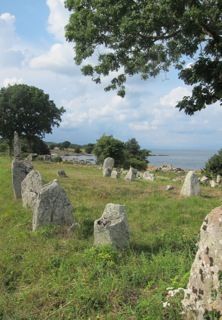About the project
Compared to earlier periods of prehistory, the accentuation of the past increased significantly in the Viking Age. In the Carolingian Renaissance the Christian Roman Empire of the 4th century AD was used as an ideal and referential point.
In contrast the Viking Age, an oral and not a written society, did not use a single period, but rediscovered and referenced multiple pasts, either materially or referentially, through material culture. Thus far, only burials have been studied with the purpose of exploring the use of the past in the Viking Age.
In the project other types of structures was also going to be examined in order to explore the use of the past comprehensively with varying levels and scales.
The recycling of material culture of the past in the Viking Age was planned to be examined in the reiteration of grave monuments at settlements and central places; it explored the raising of rune stones as a means of creating places for commemoration; and it was investigated through the utilisation of antique artefacts and objects that stylistically referred to previous centuries in the Viking Age.
Objectives
The analyses explores how past monuments and artefacts were recycled materially and referentially in this period; the different strategies of constructing places for commemoration; and the choice of objects to be preserved through centuries in order to enhance new interpretational frames of utilizing the past in the past.
As this use of the past in the Viking Age was a central, active element in the mentality and world-view, and took shape in political and social processes, the project had the scope to provide new insights into the fundamental social and cultural changes, including the changes in Old Norse belief system in the centuries prior to the conversion to Christianity, and the gradual progression toward state formation.
This also means that the results from the project will combine two research traditions that are often separated in Viking Age Research.
Financing
The Project was financed by The Research Council of Norway, FRIPRO 2016-2020 as Young ResearchTalent.
Events
Time and Temporality in the Viking Age
Time and place: Jan. 24, 2018 – Jan. 26, 2018, University of Oslo (City centre), Professorboligen, Karl Johans gate 47.
Program
Wednesday 24th
- Registration at Professorboligen
Session 1 Unn Pedersen, University of Oslo
- Organisers: Welcome and practicalities.
- Julie Lund, University of Oslo: Time and Temporality: Viking Age Scandinavia as a Renaissance?
- Keynote speaker: Andrew Reynolds, University College London: Drawing on the Past: an Archaeological Model for the Emergence of Supra-local Society from Early Medieval England.
Session 2 Marianne Moen, University of Oslo
- Anders Andrén, Stockholm University: Competing Memories. The Past in Viking Age Gotland.
- Mads Dengsø Jessen, the National Museum of Denmark: The Construction of a Past Social Reality.
- Elisabeth Arwill-Nordbladh, Gothenburg University: Material Phenomena and Temporality
- Frida Espolin Norstein, Gothenburg University: Temporalities and Inheritance: the Significance of Oval Brooches as Heirlooms.
- Marianne Hem Eriksen, Cambridge University/University of Oslo Longhouses as: Temporal Assemblages in the Iron and Viking Ages.
Thursday 25th
Session 3 Neil S. Price, Uppsala University
- Keynote speaker: Richard Bradley, University of Reading: Commemoration and Change: remembering what may not have happened.
- Simon Barker, the Norwegian Institute in Rome: Recycling the Past in Late Antiquity
- Anne Pedersen, the National Museum of Denmark: The Past in the Present – re-use of Ancient Monuments in Viking-Age and Early Medieval Denmark.
- Rebecca Cannell, University of Oslo: Burial Mound Construction as an Expression of Past, Present and Future.
Session 4 Lotte Hedeager, University of Oslo
- Patrick Gleeson, Queen’s University Belfast: Myth, the Past, and Landscapes of Kingship in Early Medieval Ireland.
- Mari Østmo, University of Oslo: Landscapes of Commemoration.
- John Ljungkvist, Uppsala University: Viking Age History Writing in Gamla Uppsala and Valsgärde – conscious relations to Past Burials and Monuments.
- Nanouschka Myrberg Burström, Stockholm University: Time, Temporality and Imitative Artefact Dialogue.
- Cancelled Maria Domeij Lundborg, The Nordic Centre of Heritage Learning and Creativity AB/Lund University: Animals of the Past – old motives in new ways.
Friday 26th
Session 5 Jan Bill, University of Oslo
- Keynote speaker: Sarah Semple, Durham University: Landscape, Identity and Power: Changing Engagements with the Past in Anglo Saxon England.
- Stine Brunstad, University of Oslo: Viking Age Runestones linking Present and Future Pasts.
- Leszek Gardeła, University of Rzeszów/Snorrastofa – Cultural and Medieval Centre in Reykholt, Iceland: Death, Mourning, and Memory: Second Fiddles in Viking Age Mortuary Practices.
- Anna Wessman, University of Helsinki: Weapons as Heirlooms.
- Panel discussion
About the conference
The conference will be the first event structured around the research project Using the Past in the Past. Viking Age Scandinavia as a Renaissance?
The project is aimed at exploring how and why the past was utilized in Viking Age Scandiavia. Compared to earlier periods of prehistory, the accentuation of the past increased significantly in the Viking Age. In the Carolingian Renaissance, the Christian Roman Empire of the 4th century AD was used as an ideal and referential point. In contrast, the Viking Age, an oral and not a written society, did not use a single period but rediscovered and referenced multiple pasts, either materially or referentially, through material culture.
We hope that by inviting a broad spectrum of scholars working with similar questions, the conference will generate engaging debates. This can form the foundations for the establishment of an international forum for researchers who work with the physical manifestations and theoretical perspectives of the Viking Age, and how these relate to varying concepts of time and temporality in contemporary archaeological thought.
Publications
Lund, Julie (2017). Connectedness with Things. Animated objects of Viking Age Scandinavia and in Early Medieval Europe. Archaeological Dialogues 24(1): 89-108
Lund, Julie & Arwill-Nordbladh, Elisabeth (2016). Divergent Ways of Relating to the Past in the Viking Age. European Journal of Archaeology 19(3): 415- 438 .
